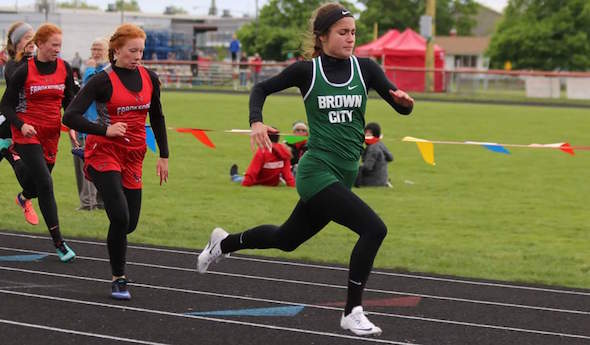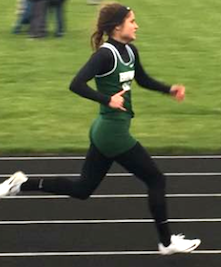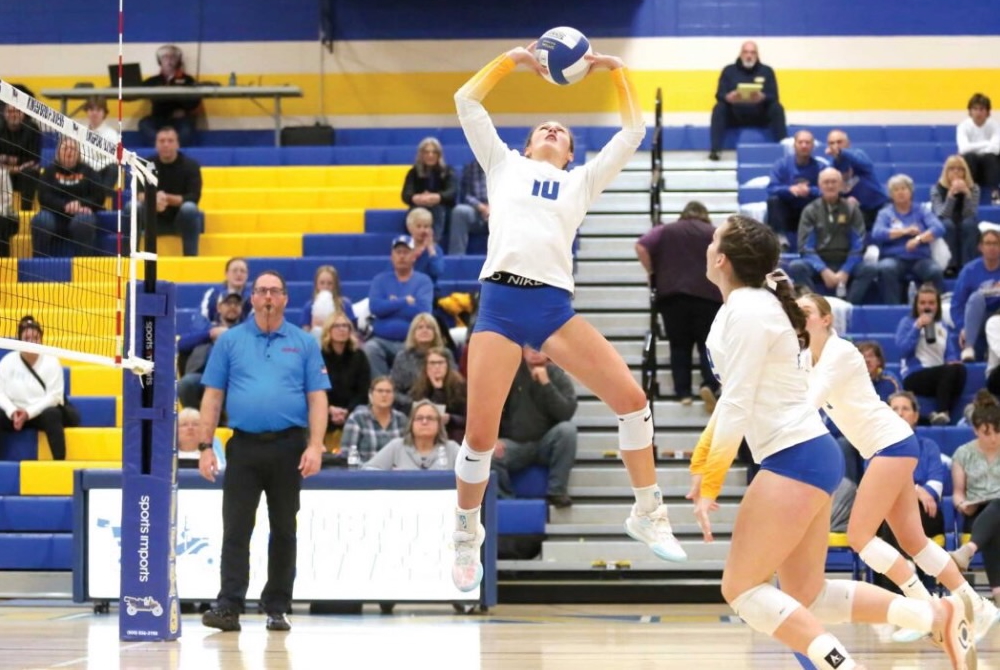
Re-focused Hanson Ready to Climb Again
By
Paul Costanzo
Special for MHSAA.com
April 6, 2018
By most any standard, Alexandra Hanson had a tremendous junior track season.
 The Brown City star didn’t lose a 100, 200 or 400-meter race in a dual or tri meet, and only finished lower than second twice prior to the MHSAA Lower Peninsula Division 3 championships, where she was all-state in all three events – fifth in the 200 and 400, and eighth in the 100.
The Brown City star didn’t lose a 100, 200 or 400-meter race in a dual or tri meet, and only finished lower than second twice prior to the MHSAA Lower Peninsula Division 3 championships, where she was all-state in all three events – fifth in the 200 and 400, and eighth in the 100.
That great season was not up to the standards of one very important person, however – Hanson – and not just because she was coming off a sophomore season that saw her win a Division 4 title in the 400 and finish second in the 200.
“I just feel like I should have at least improved a little from my previous year, and I didn’t,” said Hanson, who didn’t match any of her personal records as a junior. “I know that was because I didn’t do anything during the winter. I was just super naive about it. I thought, ‘I won a state championship, I can just do it next year.’ I definitely had the completely wrong mindset. I think I got comfortable and was not pushing myself like I should have.
“I’m trying to take it as a lesson learned. Take it as a positive.”
Hanson’s disappointment has fueled her this offseason, as she looks to finish her high school career strong and transition to Saginaw Valley State University, where she will run collegiately.
While the Green Devils don’t have a meet scheduled until April 10, and practices have been hampered by early-spring weather, the difference in Hanson can already be seen by those who know her best.
“When she won the state, she didn’t run again until we started track practice the next year, and right in the middle of track season, she got a really bad cold and missed two or three meets,” Brown City coach Don Twiss said. “When you’re an elite runner, you have to stay at that training level, you can’t afford to take that amount of time off. I’m excited about her this year, just because her motivation seems to be totally different this year.”
Hanson spent much of her summer going through workouts she had taken from the Saginaw Valley coaching staff and her other college visits. She ran cross country for Brown City in the fall, and in the winter she continued to run, albeit mostly on a treadmill.
“I feel like I’m in better shape than where I was a year ago,” Hanson said. “Every time I’m like, ‘I don’t feel like running today,’ I tell myself, ‘Well, you don’t want to be like last year.’”
Hanson’s success this season won’t be measured in how many times she crosses the finish line first – although if she is successful in meeting her goals, she’ll do that plenty.
 She’s eyeing her personal best times – 58.03 seconds in the 400, 26.01 in the 200 and 12.71 in the 100 – meaning she’ll spend most of her season running against the clock. Fortunately for her, this is something she’s grown accustomed to, as many of her races aren’t particularly close throughout the season.
She’s eyeing her personal best times – 58.03 seconds in the 400, 26.01 in the 200 and 12.71 in the 100 – meaning she’ll spend most of her season running against the clock. Fortunately for her, this is something she’s grown accustomed to, as many of her races aren’t particularly close throughout the season.
“It’s hard, especially when you’re in meets where you don’t have someone pushing you,” she said. “It’s definitely hard when you’re racing against the clock. I’m not the most personally motivated person, so my dad has to be standing there at around the 300-meter mark, and he has to scream at me. That motivates me. I have to have someone there motivating me.”
She also has her eye on a new race, as at Saginaw Valley the plan is for her to transition to middle distance and add the 800 meters to her repertoire. She ran it once as a junior, and will try it a little more this season as opportunities present themselves.
“I still think (team) points wise, I’m going to have to run the 200,” Hanson said. “But I’ll definitely run (the 800) more than last year. I’ll be able to run it more because my sister (Juliana) is here now, and she’s fast, too, so she’ll be able to take over the 100.”
Hanson is excited about the transition to middle distance, as she said the 400 has been her favorite race since she was in middle school. She’s also self aware, and said she has a better chance to get her 400 and 800 times to a level where she can compete in college, as opposed to her 100 and 200 times.
“Coming from a small town, the shorter distances I did really well in, so that’s what I did,” she said. “I talked to college coaches, and they started explaining what most 400 runners do – they go up.”
Twiss believes the potential is there for Hanson to transition to the 800 and be successful. He also believes the 400 is where she’s at her best, and that could lead to another trip to the top of the MHSAA podium in June.
“She’s like a gazelle when she gets out there and goes,” he said. “She’s such a natural middle sprinter, or like I call them, long sprints. She’s capable of running an upper 56-second (400 meters). If she does that, that will win it.”
 Paul Costanzo served as a sportswriter at The Port Huron Times Herald from 2006-15, including three years as lead sportswriter, and prior to that as sports editor at the Hillsdale Daily News from 2005-06. He can be reached at [email protected] with story ideas for Genesee, Lapeer, St. Clair, Sanilac, Huron, Tuscola, Saginaw, Bay, Arenac, Midland and Gladwin counties.
Paul Costanzo served as a sportswriter at The Port Huron Times Herald from 2006-15, including three years as lead sportswriter, and prior to that as sports editor at the Hillsdale Daily News from 2005-06. He can be reached at [email protected] with story ideas for Genesee, Lapeer, St. Clair, Sanilac, Huron, Tuscola, Saginaw, Bay, Arenac, Midland and Gladwin counties.
PHOTOS: (Top) Brown City’s Alexandra Hanson pulls away from a pack of runners during a race last season. (Middle) Hanson sprints down the stretch. (Photos courtesy of the Brown City girls track & field program.)

Kingsford's Kreider Prepared for Next Level After Finishing Stellar Flivvers Career
By
John Vrancic
Special for MHSAA.com
June 19, 2025
KINGSFORD — After completing a successful high school volleyball career, Maddy Kreider is ready to take the next step.
 The Kingsford senior is taking her talents to Michigan Tech, where she’s expected to continue primarily as a setter.
The Kingsford senior is taking her talents to Michigan Tech, where she’s expected to continue primarily as a setter.
“That will be a big step for sure, but it’ll be exciting being with the girls,” she said. “The girls are taller in college. It will definitely be an adjustment, physically and mentally. We’ll be traveling longer distances, and it’ll be a matter of improving the mental part of my game.”
Kreider was selected the Upper Peninsula’s Defensive Player of the Year her final two seasons after the U.P. Sportswriters and Sportscasters Association began voting for all-U.P. volleyball.
“That’s quite an accomplishment,” she said. “It’s a real honor playing with girls I grew up with. We had a great season.”
The 5-foot-8 setter was a four-year starter and two-year team captain at Kingsford, leading the Flivvers to three Division 2 District titles and back-to-back undefeated Great Northern Conference championships. She twice was named GNC Player of the Year.
She was also selected all-state first team in the fall and all-state second team in 2023, and all-region throughout her prep career. Her serving percentage also topped .900 throughout her four seasons on varsity.
 Last fall, the Flivvers reached the Regional Semifinal at Manistique where they dropped a 3-2 decision to Kingsley.
Last fall, the Flivvers reached the Regional Semifinal at Manistique where they dropped a 3-2 decision to Kingsley.
“I thought we’d get through,” Kreider said. “We came out lights out in the first two sets, then it was close in the last three.”
Also among the team’s highlights this past fall was a victory at Calumet, approximately 2½ weeks after dropping a 3-1 decision to the Copper Kings on Kingsford’s home floor.
“We wanted to play them,” Kreider said. “They’re a great bunch of girls to play against. They’ve been the measuring stick up here for many years. Winning on their floor was super exciting. We knew we had to play well just to be competitive. That was a great confidence builder for our group. We were definitely on a high going into the District.”
The Flivvers opened their postseason with a 3-1 triumph over Houghton, then defeated Escanaba in straight sets in the District Final.
Kreider will join Calumet senior Maddie Torola at MTU this fall. Torola, who recorded a season-high 19 kills in the four-set victory at Kingsford, helped the Copper Kings finish 29-5 and reach the Division 3 Regional Final at Sault Ste. Marie where they dropped a 3-2 decision to Traverse City St. Francis.
“It was fun playing against her in high school,” Kreider said. “It will be even more fun playing as teammates. It’ll be exciting to be playing on the same team.”
Both will be playing under new head coach Cindy Pindral at Tech. Both of Kreider’s parents played for the Huskies, her mother (and Kingsford varsity coach) Jaclynn volleyball from 1998-2002 and her father Jason basketball from 1997-2000.
Maddy Kreider recently earned an additional honor when she was selected Female Athlete of the Year for Kingsford’s Class of 2025. She recently completed a solid track & field season for the Flivvers.
At the U.P. Division 1 Finals, Kreider placed fourth in the 100-meter dash (13.2) and anchored the Flivvers to a third-place finish in the 800 relay (1:51.57) and fourth in the 400 (53.03) on their home track.
Kreider was named one of 32 MHSAA/Farm Bureau Insurance Scholar-Athlete Award winners this winter and plans to study exercise science and kinesiology at MTU.
 John Vrancic has covered high school sports in the Upper Peninsula since joining the Escanaba Daily Press staff in 1985. He is known most prominently across the peninsula for his extensive coverage of cross country and track & field that frequently appears in newspapers from the Wisconsin border to Lake Huron. He received the James Trethewey Award for Distinguished Service in 2015 from the Upper Peninsula Sportswriters and Sportscasters Association.
John Vrancic has covered high school sports in the Upper Peninsula since joining the Escanaba Daily Press staff in 1985. He is known most prominently across the peninsula for his extensive coverage of cross country and track & field that frequently appears in newspapers from the Wisconsin border to Lake Huron. He received the James Trethewey Award for Distinguished Service in 2015 from the Upper Peninsula Sportswriters and Sportscasters Association.
PHOTOS (Top) Kingsford’s Maddy Kreider sets for her teammates during a match last season. (Middle) Kreider, right, takes a photo with Kingsford’s Male Athlete of the Year Gavin Grondin. (Photos provided by the Kingsford athletic department.)

